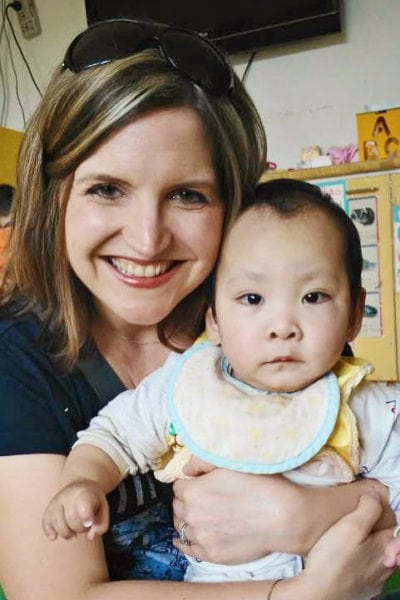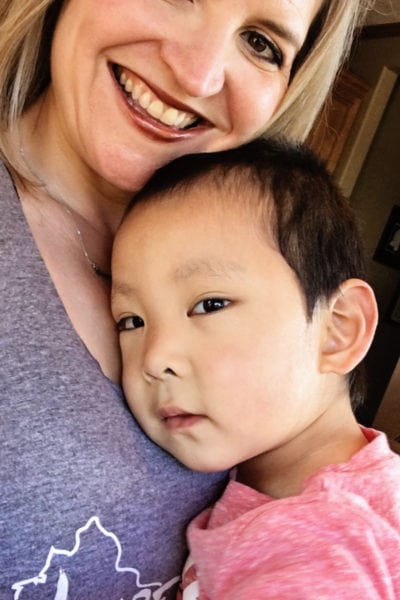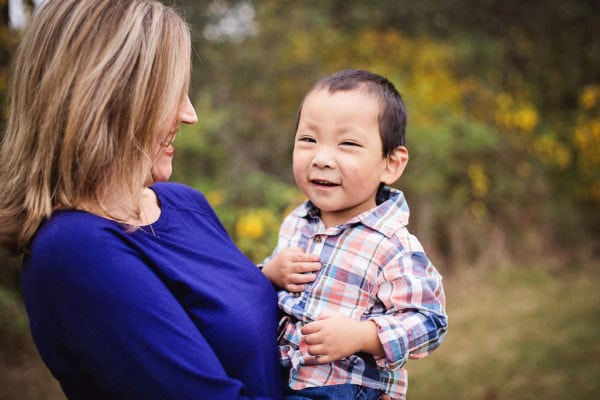Attachment. It’s a word that, at some point of the adoption journey, will bring every parent to their knees – either in frustration over all that seems to be lacking or gratitude for heart-shaped milestones reached.
This month we are focusing on attachment over the long(er) term… not weeks or months home. But years down the road. And we’ve asked our contributors to share their experience – exactly what attachment is like with their child, exactly where they are on the attachment journey.

1. Every adoptive parent starts out with certain expectations for what attachment and bonding will be like. How has your attachment looked like what you expected?
Adopting a toddler is so very different than giving birth to a newborn. With a newborn, you’re both expected to rest and relax together while bonding, but that is sometimes difficult with an older child. I acknowledged going into adoption that we would essentially bring a little stranger into our lives, and we would be strangers to him. While I had many months of dreaming of our child and longing for the day that I could hold him, our child did not.
There was definitely a period of getting to know each other, of feeling each other out and learning about each other’s personalities. I expected it to take a little while for us to feel like mother and son, and it did. While I cared for him a great deal, it was a few months before I truly felt that fierce Mama Bear love. And that is a very natural evolution in the attachment process.

2. How has your attachment looked different from what you expected?
Having adopted before, we were hopeful that we would have a similar experience both times. With our first adoption, our son was quickly entertained by our antics and eager to engage with us. It didn’t take long at all for him to seek us for comfort or to calm down in our presence.
We had a much different experience with our second adoption. Our little guy already had a longer period of time living without a family and learning to live without much physical touch and interaction. In his short life, we were his fifth place to land – I can’t even guess how many caregivers he had in his life prior to us.
Cuddling with mom and having his needs met were not a priority for him. In fact, he was not very interested in me at all. He rejected me cradling him and holding a bottle for him. He screamed and arched his back repeatedly trying to get away from me in favor of lying alone in the floor. It broke my heart to watch him rock back and forth in his crib to fall asleep. He didn’t need us or want us, and he was fine with that. It was engrained in him.
It was a fight, in some ways, to get him to accept us as caregivers let alone as loving parents who sought attachment with him.
3. Have you ever felt like you could say, “we are attached”? If so, when?
Yes, I can absolutely say, “we are attached.” It was not without a fight on our part. I wore him in the Ergo everywhere, even if it was against his will. Otherwise, he would reach for every passing stranger to take him. I took over feeding him, even though he would have preferred to lie in the floor with a bottle by himself.
The “when” part is such a tough one to answer. Now, two years in, it’s hard to recall a time when he didn’t need me and truly want me to be with him. Now, two years in, I can’t imagine our lives without him, and I don’t recall a time when that statement wasn’t at the forefront of my heart. Now, two years in, I can’t remember a time when his eyes didn’t light up when I got him out of the crib in the morning or when he didn’t melt into my arms to snuggle.
But I can look back at the pictures and I can see his distant stare. I can see his half smile. I can watch the videos and notice the lack of genuine, deep belly laughter, and it brings me back to the time that he wasn’t a happy little boy with abundant love for us. Based on that, I’d have to guess that things began to change around 9-10 months home.
Now, two years in, he is overjoyed when I return from the grocery store, running to me for a big hug. Now, he seeks me for comfort when he gets a little boo boo on his knee. Now, he delights in showing me something he drew or a pretend birthday cake he made out of his stacking cups.
He is a different child than we brought home two years ago in almost every aspect.

4. What are three things you are glad you did to build attachment?
– We ignored his chronological age. By his age at adoption, I would have expected my biological children to feed themselves and entertain themselves for a brief period of time. With a child that didn’t want to attach though, I reframed everything as if we were starting at ground zero with him. Instead, I looked at his family age. At his family age of 6 months (over 2 years old by chronological age), I would spoon feeding him at mealtime. I didn’t expect anything more from him that I would of a baby of 6 months old.
I think it’s easy for us as parents to play the comparison game and get frustrated when it feels like our kiddos aren’t on par with other children their age. One of the greatest gifts we can give our children from hard places is to remove our expectations of “normal” and simply encourage them to meet their potential in their own time.
We continue to celebrate him and his milestones even if they are behind what’s considered typical.
– We provided routines. With five children, our schedule is often hectic, running from practices to games to programs. While we can’t have a strict schedule on a day to day basis, we can still incorporate routines that we do every day.
Our routines aren’t anything time consuming or out of the ordinary. They are, in fact, very simple, but they are consistent and predictable. Even at two years home, our morning, naptime, and evening routines are still the same. For example, every night, our son knows that after bath, we go get his cup of water, go upstairs, put the cup on his bed, brush teeth, read one book, sing the same song, and then go to bed. I have sung the same Mandarin song every single night for the past three years since our first adoption! Both of our youngest kiddos expect it (and even demand it if I somehow get sidetracked and forget).
No matter how chaotic our schedule is for the day, these boring old established routines provide security and predictability for them. And they’re easily “portable,” meaning that even when we travel, we can still provide these comforts at hotels or at grandparents’ houses and give them familiarity.
– We practiced modified cocooning. As a larger family with five children, we could not stay hidden away at home for weeks or months after returning home. For us, cocooning entailed things like co-sleeping, limiting contact with extended family, friends and strangers, and ensuring that mom or dad did almost all of the caregiving for our new son.
5. Two years out, what is something you would do differently if you were to do it all over again?
I would have learned to say no to other people and to whittle down my commitments outside of my family much earlier than I did. I held on tightly to pre-adoption Brandie and the roles I played in the community. While they were absolutely good and positive roles and things that I truly enjoyed doing, they caused stress for our sons and me when I attempted to fulfill these roles.
For example, while I was trying to lead a moms group, I spent the majority of the time engaging with my children and ensuring that they were comfortable and happy. I could either be a great leader or a great mom, but at that time, both couldn’t exist simultaneously. Obviously, being Mom was the choice I had to make.
I would have acknowledged sooner that adoption rocked our world as we navigated the challenges of attachment and bonding.

6. How would you encourage an adoptive parent a few years behind you regarding the attachment journey?
– Read everything you can get your hands on regarding attachment in adoption. If you are in the beginning stages of your adoption or newly home, talk to as many adoptive parents as you possibly can so that you prepare yourself for both the positives and the negatives.
– Attachment is truly a journey of time. Signing paperwork that makes you mom and dad is a formality that takes minutes of your life. Attachment is built day after day, month after month, year after year of consistent actions that tell your child, “You can trust me to meet your needs.”


























Leave a Reply